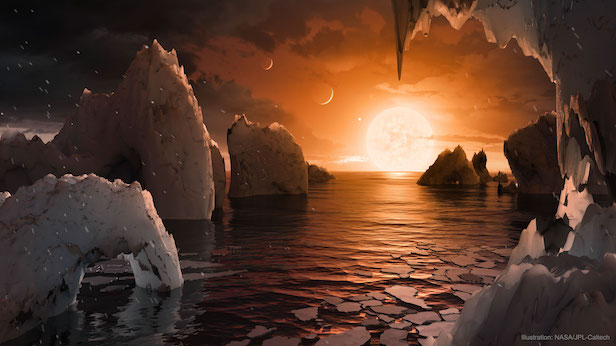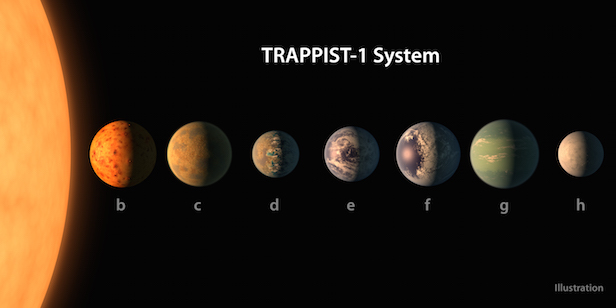Two of the TRAPPIST-1 planets are most likely to harbour life
Two out of the seven Earth-sized planets could provide the best environment for life to thrive

All seven of the TRAPPIST-1 planets are packed-in close to the star. In fact, they are closer to their host star than Mercury is to the Sun. Image credit: NASA/JPL-Caltech/Spitzer/T. Pyle
Out of the seven exoplanets orbiting the TRAPPIST-1 system, two of them have been singled out for being most likely to have habitable conditions. The recent study has stated that the two planets receive appropriate heat and contain a probable water source that is essential for life to thrive.
The intriguing planetary system was discovered almost a year ago. Since then, it has been the subject of much research due to its potentially habitable properties. With all seven exoplanets being roughly Earth-sized, and located just 39-light-years away, this sparked a hunt for alien life.
“Because the TRAPPIST-1 star is very old and dim, the surfaces of the planets have relatively cool temperatures by planetary standards, ranging from 400 degrees Kelvin (260 degrees Fahrenheit), which is cooler than Venus, to 167 degrees Kelvin (-159 degrees Fahrenheit), which is colder than Earth’s poles,” says Amy Barr, senior scientist at the Planetary Science Institute. “The planets also orbit very close to the star, with orbital periods of a few days. Because their orbits are eccentric – not quite circular – these planets could experience tidal heating, just like the moons of Jupiter and Saturn.”
The seven planets that orbit the red dwarf star are given a designated letter, ranging from b to h, with b being the closest planet to the star and h being the furthest. Vera Dobos, assistant research fellow at Konkoly Observatory, Hungary, shows that the planets TRAPPIST-1d and e are the most likely planets to be habitable. The two planets should have moderate surface temperatures, generous amounts of tidal heating – internal heating because of the host star’s gravitational pull – and low enough fluxes to avoid a greenhouse gas runaway. TRAPPIST-1d is even more likely, as there is believed to be a global water ocean covering the surface.

The seven exoplanets are all roughly the same size of Earth. Image credit: NASA/R. Hurt/T. Pyle
The group of researchers calculated the balance between the tidal heating and the heat transport convection in the mantles of each planet. From this analysis, the team also deduced that planet b and c are most likely to have partially molten-rock mantles. It appears planet c also has a solid-rock surface, producing eruptions of silicate magmas much like Jupiter’s moon Io.
“Assuming the planets are composed of water ice, rock and iron, we determine how much of each might be present, and how thick the different layers would be. Because the masses and radii of the planets are not very well constrained, we show the full range of possible interior structures and interior compositions,” say Barr. The results of this work have shown that with improved estimates of the masses of each planet, astronomers can single out which planets have a significant amount of water.
Keep up to date with the latest reviews in All About Space – available every month for just £4.99. Alternatively you can subscribe here for a fraction of the price!




